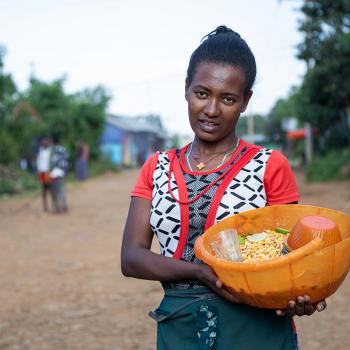
New research from our Listening to Young Lives at Work: COVID-19 Phone Survey, in Ethiopia, India (Andhra Pradesh and Telangana), Peru, and Vietnam, published last week, shows that widening inequalities and ongoing socio-economic impacts of the Covid-19 pandemic are continuing to derail prospects for a generation of young people, hitting those from poor households and marginalised groups hardest.
Two years on from the start of the pandemic, our four study countries are each facing significant economic and social challenges, and rapidly changing circumstances. But COVID-19 is not the only global crisis; our evidence from Ethiopia reflects unprecedented times, as vulnerable families grapple with the compounding effects of civil conflict and climate change, including an alarming increase in food insecurity in the south-western region, alongside the devastating impact of the Tigray conflict in the north.
In this blog, we present key findings from the fifth call in our phone survey (‘Call 5’), conducted in October to December 2021, showing how the pandemic and other crises are threatening the achievement of the Sustainable Development Goals (SDGs), which are critical for young people trying to build a more prosperous future.
In Call 5, we found that increasing levels of poverty are hitting marginalised groups hardest. An increasing number of Young Lives households have described themselves as struggling to satisfy basic needs since the beginning of the pandemic, with evidence of disadvantaged groups becoming stuck in deep pockets of poverty:
- In Ethiopia, the number of Young Lives households that consider themselves struggling, poor, or destitute nearly doubled from 34% pre-pandemic to 63% in 2021.
- In Peru, increasing levels of poverty were reported among those whose mother tongue is not Spanish, with struggling, poor, or destitute households increasing from 41% before the pandemic to 53% by October-December 2021 (compared to only 20% for those whose first language is Spanish).
- In India, those belonging to Scheduled Castes or Scheduled Tribes who considered themselves struggling, poor, or destitute increased from 44% before the pandemic to 58% by October–December 2021 (compared to 40% across all other groups).
- In Vietnam, those from minority ethnic groups were three times more likely to consider themselves living in households that were struggling, poor, or destitute (24%), compared to those from the majority ethnic group (7%).
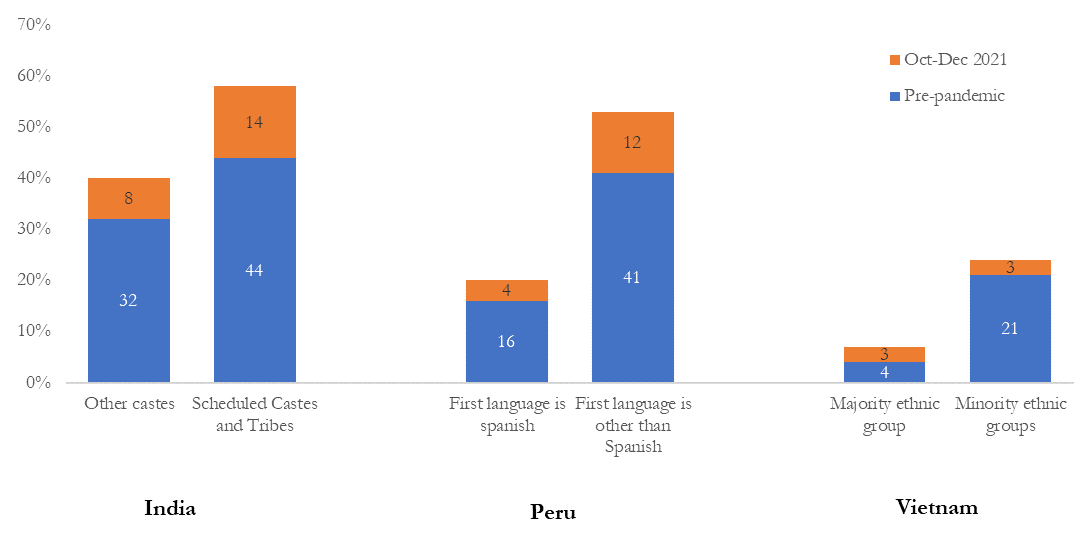
Figure 1: Proportion of young people who consider their household to be struggling to satisfy basic needs (including poor or destitute): pre-pandemic vs October-December 2021
Our second key finding was that more families were worried about going hungry, with severe food insecurity in drought-prone regions. An increasing number of Young Lives households worried about running out of food in 2021 (mild food insecurity), compared to 2020, with those from marginalised groups most affected. However, we have also seen increasing worries about adequate food supplies among better-off households in Peru, and among urban areas in Ethiopia.
Although, on average, we have seen fewer families actually running out of food (severe food insecurity), compared to 2020, alarming levels of severe food insecurity have been reported in the Southern Nations, Nationalities, and Peoples’ Region (SNNPR) of Ethiopia due to severe drought exacerbated by high inflation and locust swarms:
- More than 40% of families in drought-affected SNNPR in Ethiopia ran out of food in 2021, and 75% of families were worried about running out of food – a near 100% increase on 2020 figures.
- In India, 44% of young people had worried about running out of food in 2021 (including 52% among Scheduled Castes and Tribes), compared to 13% reported in 2020.
- In Vietnam, 29% of young people had worried about running out of food in 2021, compared to only 14% in 2020, with increases reported even among wealthier households. Minority ethnic groups have been disproportionately affected, with 19% running out of food in 2021, compared to only 3% among the majority ethnic group.
Despite national vaccination programmes accelerating over the second half of 2021, we found unequal vaccination rates both between and within our study countries, putting those in poorer, rural households and vulnerable groups at greater risk of COVID-19. While our results showed relatively high vaccination rates in India, Peru and Vietnam, the vaccination rate in Ethiopia was exceptionally low, with limited access to testing and evidence of vaccine hesitancy (though vaccination rates are beginning to accelerate in early 2022).
Our findings reflect urgent global debates on addressing the profound vaccine inequality between low-income countries and the rest of the world. Significant vaccine inequality within countries is also putting vulnerable communities at risk, with uneven roll outs resulting in those from poorer households, (remoter) rural areas and marginalised groups being less likely to have received a first dose.
- In India, Peru and Vietnam, 65%, 57% and 62% of young people in our survey had received at least one dose by October-December 2021, respectively.
- In Ethiopia, vaccination rates were very low with only 3% having received their first dose by October-December 2021. Worryingly, our results indicate high rates of vaccine hesitancy, with 29% of young people saying they would not get a vaccine if available.
- In Peru, only 41% of those whose mother tongue is not Spanish had received their first dose, compared to 67% for those whose first language is Spanish.
- In India, only 59% of those from Scheduled Castes and Tribes had received their first dose, compared to 68% among other groups.
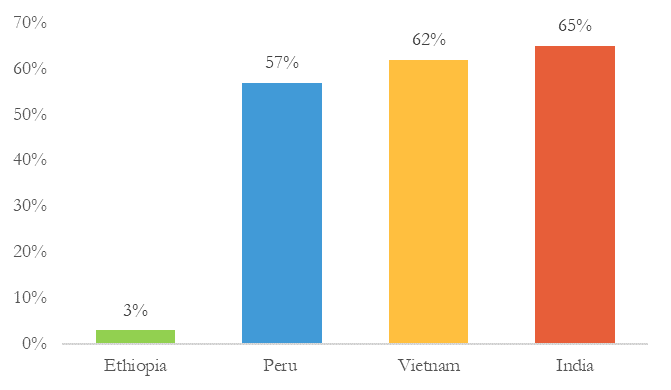
Figure 2: Proportion of Young Lives respondents with at least one Covid-19 vaccine dose, October-December 2021
The impact of the pandemic on young people’s mental health has been a concern throughout our phone survey. In Call 5, we found that high levels of anxiety and depression are still being reported. The pandemic has continued to have a negative impact on young people’s mental health, at a time when access to often limited mental health services may have been significantly disrupted. Vietnam has seen a dramatic increase in young people’s experience of both anxiety and depression, corresponding to the dramatic fourth wave of COVID-19 in 2021, following relatively low levels reported in 2020.
- In Peru, reported rates of mental health issues remain alarmingly high, with 30% of young people experiencing anxiety and 24% reporting symptoms of depression in October-December 2021, compared to pre-pandemic average depression levels of 18%, as reported in the 2019 Demographic and Health Survey.
- In Vietnam, the number of young people suffering from depression (12%) had doubled by October-December 2021, compared to the previous year, with reported levels of anxiety increasing from 5% to 8% over the same period.
The pandemic continues to have a significant and unequal impact on education, particularly for students from poorer households and marginalised communities, putting the goal of achieving twelve years of quality education for all under threat. In Call 5, we found that a clear digital divide is limiting young people’s chances of successful education, particularly in rural areas, and increasing the likelihood of dropping out. Young Lives students (now aged 19-20 years) also reported a significant decline in the quality of education, suggesting that the low effectiveness of remote learning has exacerbated the learning crisis across many low- and middle-income countries.
- In Peru, almost one in five (19%) of 19-20-year-old students had dropped out of education for reasons other than completing their course.
- In Vietnam, 22% of 19-20-year-old students with no internet access had dropped out of education, compared to only 3% among those with internet access.
- Just under half of all Young Lives 19–20-year-old students reported that the quality of their learning had declined compared to before the pandemic (55% in Vietnam, 51% in Peru, 47% in India and 30% in Ethiopia).
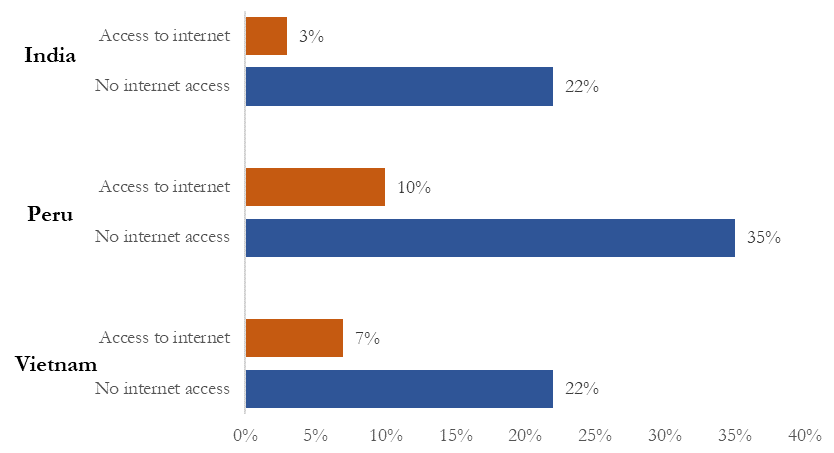
Figure 3: Digital divide: Percentage of Young Lives students who dropped out of education due to reasons other than their course finishing
An increasing gender employment gap is undermining overall employment recovery, with evidence suggesting the quality of jobs may also be deteriorating. Although employment continued to recover in 2021, many young women in our older cohort (now aged 26-27 years) have not been able to return to work, with our analysis suggesting that the unequal burden of caring responsibilities has directly contributed to gender disparities in employment recovery. A continuing shift towards more self-employment and agricultural work suggests that the quality of jobs may also have deteriorated in some areas, particularly among those from rural and the poorest households.
- In Peru, the gender employment gap among 26–27-year-olds increased from 11 percentage-points before the pandemic to 24 percentage-points by October-December 2021; in India, this gap increased from 39 percentage-points to 49 percentage-points over the same period.
- Increasing numbers of 26-27-year-olds are working in agriculture: in Ethiopia, this increased from 49% before the pandemic to 53% by October-December 2021; and in India, from 42% to 47% .
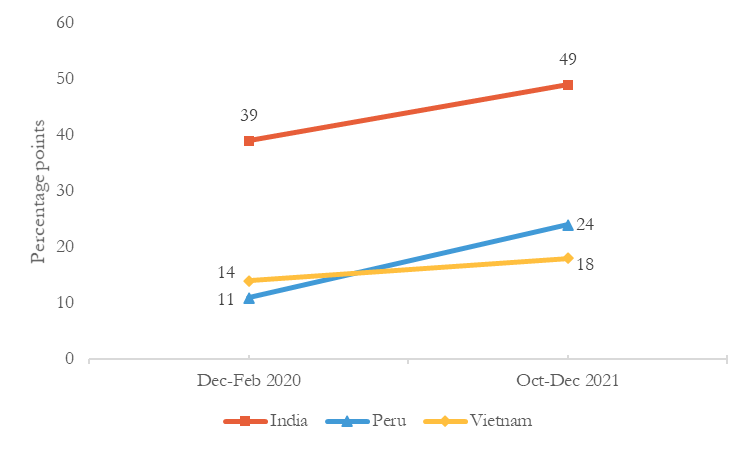
Figure 4: Increase in gender employment gap among 26–27-year-olds: pre-pandemic vs October-December 2021
In conclusion, the scale of challenges currently facing vulnerable young people in low-and middle-countries requires urgent action if we are to get progress towards the SDGs back on track. Young Lives will be publishing emerging policy recommendations, to inform related policies and programmes, at the end of March 2022. We will also be undertaking further analysis of our findings, including on food security, education, work, and mental health, working closely with our long-term study country partners.
Young Lives is presenting new findings and showcasing a number of innovative research methods developed as part of the COVID-19 phone survey at our forthcoming webinar on 28th March 2022 13:00 – 14:00 GMT; registration to join the event can be accessed through Eventbrite here.

New research from our Listening to Young Lives at Work: COVID-19 Phone Survey, in Ethiopia, India (Andhra Pradesh and Telangana), Peru, and Vietnam, published last week, shows that widening inequalities and ongoing socio-economic impacts of the Covid-19 pandemic are continuing to derail prospects for a generation of young people, hitting those from poor households and marginalised groups hardest.
Two years on from the start of the pandemic, our four study countries are each facing significant economic and social challenges, and rapidly changing circumstances. But COVID-19 is not the only global crisis; our evidence from Ethiopia reflects unprecedented times, as vulnerable families grapple with the compounding effects of civil conflict and climate change, including an alarming increase in food insecurity in the south-western region, alongside the devastating impact of the Tigray conflict in the north.
In this blog, we present key findings from the fifth call in our phone survey (‘Call 5’), conducted in October to December 2021, showing how the pandemic and other crises are threatening the achievement of the Sustainable Development Goals (SDGs), which are critical for young people trying to build a more prosperous future.
In Call 5, we found that increasing levels of poverty are hitting marginalised groups hardest. An increasing number of Young Lives households have described themselves as struggling to satisfy basic needs since the beginning of the pandemic, with evidence of disadvantaged groups becoming stuck in deep pockets of poverty:
- In Ethiopia, the number of Young Lives households that consider themselves struggling, poor, or destitute nearly doubled from 34% pre-pandemic to 63% in 2021.
- In Peru, increasing levels of poverty were reported among those whose mother tongue is not Spanish, with struggling, poor, or destitute households increasing from 41% before the pandemic to 53% by October-December 2021 (compared to only 20% for those whose first language is Spanish).
- In India, those belonging to Scheduled Castes or Scheduled Tribes who considered themselves struggling, poor, or destitute increased from 44% before the pandemic to 58% by October–December 2021 (compared to 40% across all other groups).
- In Vietnam, those from minority ethnic groups were three times more likely to consider themselves living in households that were struggling, poor, or destitute (24%), compared to those from the majority ethnic group (7%).

Figure 1: Proportion of young people who consider their household to be struggling to satisfy basic needs (including poor or destitute): pre-pandemic vs October-December 2021
Our second key finding was that more families were worried about going hungry, with severe food insecurity in drought-prone regions. An increasing number of Young Lives households worried about running out of food in 2021 (mild food insecurity), compared to 2020, with those from marginalised groups most affected. However, we have also seen increasing worries about adequate food supplies among better-off households in Peru, and among urban areas in Ethiopia.
Although, on average, we have seen fewer families actually running out of food (severe food insecurity), compared to 2020, alarming levels of severe food insecurity have been reported in the Southern Nations, Nationalities, and Peoples’ Region (SNNPR) of Ethiopia due to severe drought exacerbated by high inflation and locust swarms:
- More than 40% of families in drought-affected SNNPR in Ethiopia ran out of food in 2021, and 75% of families were worried about running out of food – a near 100% increase on 2020 figures.
- In India, 44% of young people had worried about running out of food in 2021 (including 52% among Scheduled Castes and Tribes), compared to 13% reported in 2020.
- In Vietnam, 29% of young people had worried about running out of food in 2021, compared to only 14% in 2020, with increases reported even among wealthier households. Minority ethnic groups have been disproportionately affected, with 19% running out of food in 2021, compared to only 3% among the majority ethnic group.
Despite national vaccination programmes accelerating over the second half of 2021, we found unequal vaccination rates both between and within our study countries, putting those in poorer, rural households and vulnerable groups at greater risk of COVID-19. While our results showed relatively high vaccination rates in India, Peru and Vietnam, the vaccination rate in Ethiopia was exceptionally low, with limited access to testing and evidence of vaccine hesitancy (though vaccination rates are beginning to accelerate in early 2022).
Our findings reflect urgent global debates on addressing the profound vaccine inequality between low-income countries and the rest of the world. Significant vaccine inequality within countries is also putting vulnerable communities at risk, with uneven roll outs resulting in those from poorer households, (remoter) rural areas and marginalised groups being less likely to have received a first dose.
- In India, Peru and Vietnam, 65%, 57% and 62% of young people in our survey had received at least one dose by October-December 2021, respectively.
- In Ethiopia, vaccination rates were very low with only 3% having received their first dose by October-December 2021. Worryingly, our results indicate high rates of vaccine hesitancy, with 29% of young people saying they would not get a vaccine if available.
- In Peru, only 41% of those whose mother tongue is not Spanish had received their first dose, compared to 67% for those whose first language is Spanish.
- In India, only 59% of those from Scheduled Castes and Tribes had received their first dose, compared to 68% among other groups.

Figure 2: Proportion of Young Lives respondents with at least one Covid-19 vaccine dose, October-December 2021
The impact of the pandemic on young people’s mental health has been a concern throughout our phone survey. In Call 5, we found that high levels of anxiety and depression are still being reported. The pandemic has continued to have a negative impact on young people’s mental health, at a time when access to often limited mental health services may have been significantly disrupted. Vietnam has seen a dramatic increase in young people’s experience of both anxiety and depression, corresponding to the dramatic fourth wave of COVID-19 in 2021, following relatively low levels reported in 2020.
- In Peru, reported rates of mental health issues remain alarmingly high, with 30% of young people experiencing anxiety and 24% reporting symptoms of depression in October-December 2021, compared to pre-pandemic average depression levels of 18%, as reported in the 2019 Demographic and Health Survey.
- In Vietnam, the number of young people suffering from depression (12%) had doubled by October-December 2021, compared to the previous year, with reported levels of anxiety increasing from 5% to 8% over the same period.
The pandemic continues to have a significant and unequal impact on education, particularly for students from poorer households and marginalised communities, putting the goal of achieving twelve years of quality education for all under threat. In Call 5, we found that a clear digital divide is limiting young people’s chances of successful education, particularly in rural areas, and increasing the likelihood of dropping out. Young Lives students (now aged 19-20 years) also reported a significant decline in the quality of education, suggesting that the low effectiveness of remote learning has exacerbated the learning crisis across many low- and middle-income countries.
- In Peru, almost one in five (19%) of 19-20-year-old students had dropped out of education for reasons other than completing their course.
- In Vietnam, 22% of 19-20-year-old students with no internet access had dropped out of education, compared to only 3% among those with internet access.
- Just under half of all Young Lives 19–20-year-old students reported that the quality of their learning had declined compared to before the pandemic (55% in Vietnam, 51% in Peru, 47% in India and 30% in Ethiopia).

Figure 3: Digital divide: Percentage of Young Lives students who dropped out of education due to reasons other than their course finishing
An increasing gender employment gap is undermining overall employment recovery, with evidence suggesting the quality of jobs may also be deteriorating. Although employment continued to recover in 2021, many young women in our older cohort (now aged 26-27 years) have not been able to return to work, with our analysis suggesting that the unequal burden of caring responsibilities has directly contributed to gender disparities in employment recovery. A continuing shift towards more self-employment and agricultural work suggests that the quality of jobs may also have deteriorated in some areas, particularly among those from rural and the poorest households.
- In Peru, the gender employment gap among 26–27-year-olds increased from 11 percentage-points before the pandemic to 24 percentage-points by October-December 2021; in India, this gap increased from 39 percentage-points to 49 percentage-points over the same period.
- Increasing numbers of 26-27-year-olds are working in agriculture: in Ethiopia, this increased from 49% before the pandemic to 53% by October-December 2021; and in India, from 42% to 47% .

Figure 4: Increase in gender employment gap among 26–27-year-olds: pre-pandemic vs October-December 2021
In conclusion, the scale of challenges currently facing vulnerable young people in low-and middle-countries requires urgent action if we are to get progress towards the SDGs back on track. Young Lives will be publishing emerging policy recommendations, to inform related policies and programmes, at the end of March 2022. We will also be undertaking further analysis of our findings, including on food security, education, work, and mental health, working closely with our long-term study country partners.
Young Lives is presenting new findings and showcasing a number of innovative research methods developed as part of the COVID-19 phone survey at our forthcoming webinar on 28th March 2022 13:00 – 14:00 GMT; registration to join the event can be accessed through Eventbrite here.

